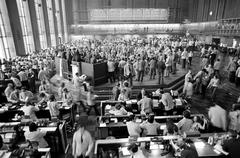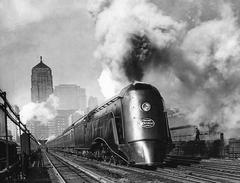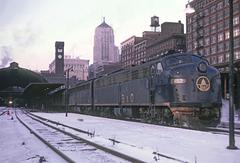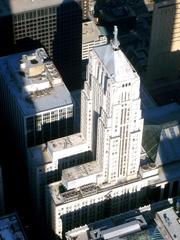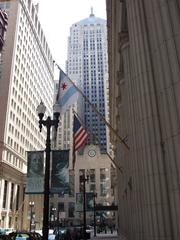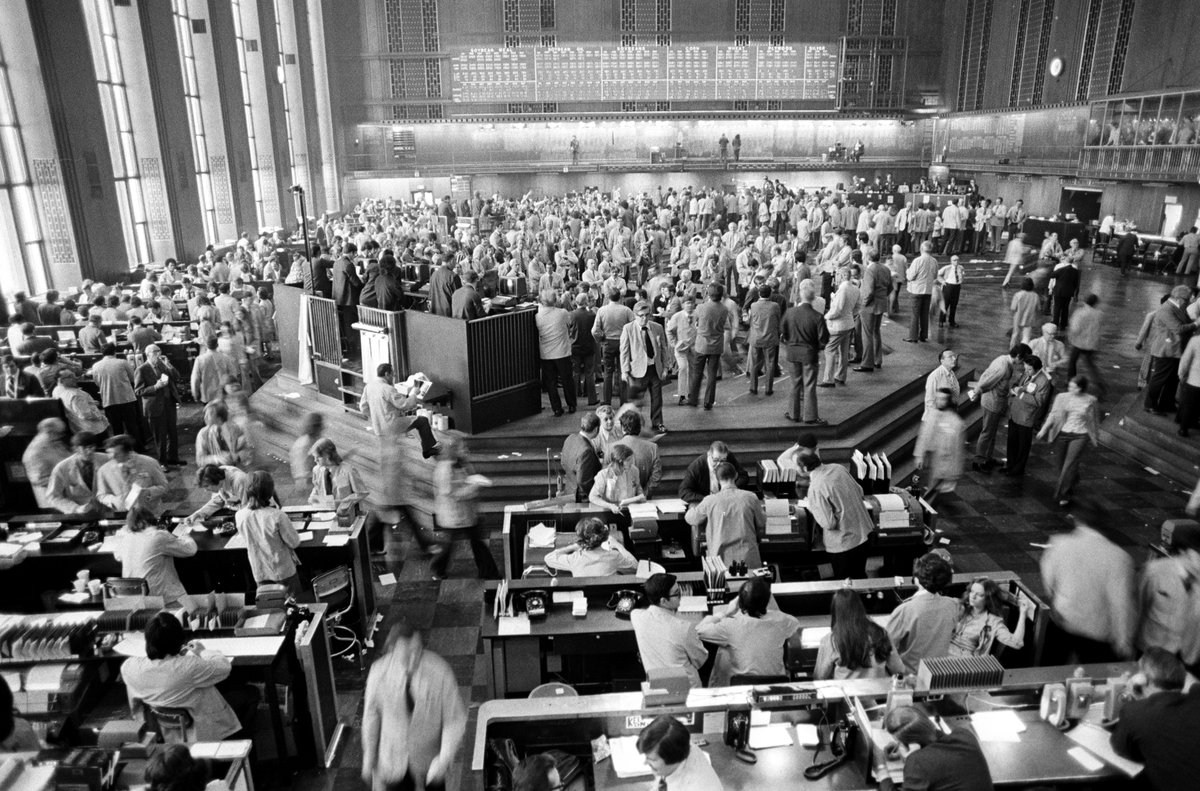
Chicago Board of Trade Building: Visiting Hours, Tickets, and Historical Guide
Date: 14/06/2025
Introduction
The Chicago Board of Trade Building (CBOT) stands as a defining symbol of Chicago’s economic power, architectural innovation, and cultural heritage. Completed in 1930 and located at 141 West Jackson Boulevard in the heart of the Loop, the CBOT is both an operational financial center and a celebrated Art Deco skyscraper. This comprehensive guide covers everything you need to know about visiting the CBOT, including hours of operation, ticketing and tours, accessibility, key historical highlights, and nearby attractions. Whether you’re an architecture enthusiast, history buff, or casual visitor, this article will help you make the most of your experience at one of Chicago’s premier landmarks. For the latest updates on visiting hours and tour availability, consult the Chicago Architecture Center and the official CBOT Building website.
Table of Contents
- Introduction
- Historical Background and Economic Significance
- Architectural and Artistic Highlights
- Visiting Hours, Tickets, and Tours
- Accessibility and Visitor Information
- Practical Tips and Etiquette
- Nearby Attractions
- Frequently Asked Questions (FAQ)
- References and Official Sources
Historical Background and Economic Significance
Origins and Growth of the CBOT
Founded in 1848, the Chicago Board of Trade was established to bring order to the city’s rapidly growing grain markets. Chicago’s strategic position at the base of the Great Lakes, surrounded by fertile farmlands, made it a natural hub for agricultural commerce (theclio.com). By the late 19th century, the CBOT became the world’s leading grain exchange, shaping Chicago’s identity as the “marketplace to the world.” The exchange’s early years saw it move through several locations, ultimately settling at its present site in 1885.
The Art Deco Landmark
The current CBOT Building, designed by Holabird & Root, was completed in 1930. At 605 feet (184 meters) and 45 stories, it was the tallest building in Chicago until 1965, anchoring the southern end of LaSalle Street—the city’s financial canyon (cbotbuilding.com). The building’s construction marked a turning point in American skyscraper design and reflected the ambitions of a city at the center of global commerce.
Impact on Global Finance
Over time, the CBOT expanded beyond agricultural commodities, becoming a global center for the trading of metals, energy, and financial derivatives. Its 2007 merger with the Chicago Mercantile Exchange formed the CME Group, now the world’s largest derivatives marketplace (CME Group). Billions of dollars in contracts are traded daily, influencing global prices and attracting a dense cluster of financial institutions to the area.
Architectural and Artistic Highlights
Signature Art Deco Features
The CBOT Building is widely regarded as one of the finest Art Deco structures in the United States (Chicago Architecture Center). Its Indiana limestone façade, stepped setbacks, and geometric ornamentation are classic elements of the style. The building’s verticality and clean lines express the optimism of early 20th-century Chicago.
Iconic Sculptures
- Ceres Statue: The 31-foot, 6,500-pound aluminum statue of Ceres, the Roman goddess of agriculture, crowns the building. Sculpted by John H. Storrs, the faceless statue holds wheat and corn, symbolizing the building’s roots in commodities trading (The Chicago Traveler).
- Façade Reliefs: Hooded figures flank the 13-foot clock on LaSalle Street—one representing a Babylonian with grain, the other a Native American with corn.
- Industry and Agriculture Statues: Granite statues on the plaza, salvaged from the 1885 building, serve as allegorical guardians.
Interior Design
The building’s grand lobby is a showpiece of Art Deco luxury, featuring marble piers, gilded bronze details, and a dramatic wraparound light fixture (chicagodetours.com). The historic trading floor, once the largest in the world, is occasionally accessible during guided tours.
Visiting Hours, Tickets, and Tours
Hours and Admission
- Lobby Hours: Monday through Friday, 8:00 AM to 6:00 PM. Entry to the lobby is free.
- Guided Tours: Offered monthly by the Chicago Architecture Center, usually on weekends. Tours typically include the lobby, trading floor, and key architectural features.
- Tickets: No entry fee for the lobby; guided tours generally cost around $20 per person. Advance booking is strongly recommended, as tours fill quickly and are not available daily.
Tour Highlights
Guided tours provide in-depth exploration of the CBOT’s history, design, and ongoing financial significance. Some tours grant access to areas not open to the general public, such as the historic trading floor and boardrooms.
Accessibility and Visitor Information
- Wheelchair Accessibility: The CBOT Building is fully accessible, with ramps and elevators throughout. Visitors with specific needs should contact tour organizers in advance.
- Service Animals: Permitted in accordance with ADA requirements.
- Language Support: Tours are primarily conducted in English, but some guides offer materials in additional languages upon request.
- Security: All visitors pass through security screening and may be asked for photo ID.
Practical Tips and Etiquette
- Dress Code: Business casual is recommended, especially for guided tours.
- Photography: Permitted in public areas such as the lobby and exterior, but avoid using flash or tripods. Permission is required for professional photography or filming.
- Conduct: The CBOT is an active workplace—maintain respectful behavior and keep noise to a minimum.
- Restrooms: Available in the public lobby.
- Lost and Found: Inquire at the security desk.
Nearby Attractions
- Willis Tower: Just a few blocks away, with an observation deck offering panoramic city views.
- Federal Reserve Bank of Chicago: Features a free Money Museum.
- The Rookery Building and LaSalle Street: Explore more of Chicago’s historic architecture and financial institutions.
- Dining and Shopping: Numerous options are available in the Loop, including on-site cafés and nearby restaurants.
Frequently Asked Questions (FAQ)
Q: What are the Chicago Board of Trade Building visiting hours?
A: The public lobby is open Monday through Friday, 8:00 AM to 6:00 PM.
Q: Are guided tours available?
A: Yes, but only on select days through organizations like the Chicago Architecture Center. Advance reservations are required.
Q: Is there an admission fee?
A: Lobby entry is free. Guided tours typically require a ticket purchase.
Q: Is the building wheelchair accessible?
A: Yes, it is fully accessible.
Q: Can I take photos inside?
A: Photography is allowed in public areas without flash or tripods. Restrictions may apply in certain spaces.
Q: Where can I purchase tour tickets?
A: Through the Chicago Architecture Center.
References and Official Sources
- Visiting the Chicago Board of Trade Building: Hours, Tickets, and Historical Insights, The Clio
- Chicago Board of Trade Building official history, CBOT Building
- Chicago Board of Trade Building, Wikipedia
- Chicago Board of Trade Building, Britannica
- Chicago Board of Trade Building: Visiting Hours, Tickets, and Architectural Highlights, The Chicago Traveler
- Chicago Architecture Center: Visit Buildings - Chicago Board of Trade
- Lakefront Historian: Ceres, the Chicago Board of Trade, Women, and Industry in 20th Century Chicago
- Chicago Board of Trade Building Visiting Hours, Tours, and Historical Guide, Travalour
- CME Group History
- R2 Portfolio: Chicago Board of Trade Building
Plan Your Visit
To experience the rich history and stunning architecture of the Chicago Board of Trade Building, plan ahead using official resources. For up-to-date information on tours, hours, and accessibility, visit the Chicago Architecture Center and CBOT Building website. Download the Audiala app for curated tours, maps, and exclusive Chicago content. Connect with us on social media for real-time updates, insider tips, and more on Chicago’s historic sites.
